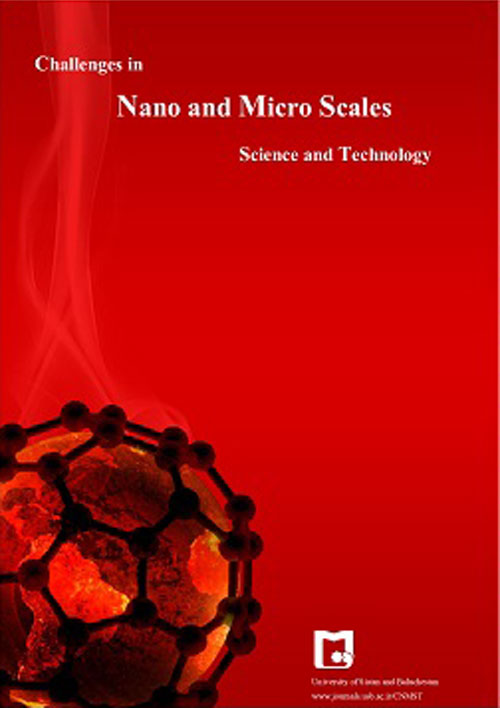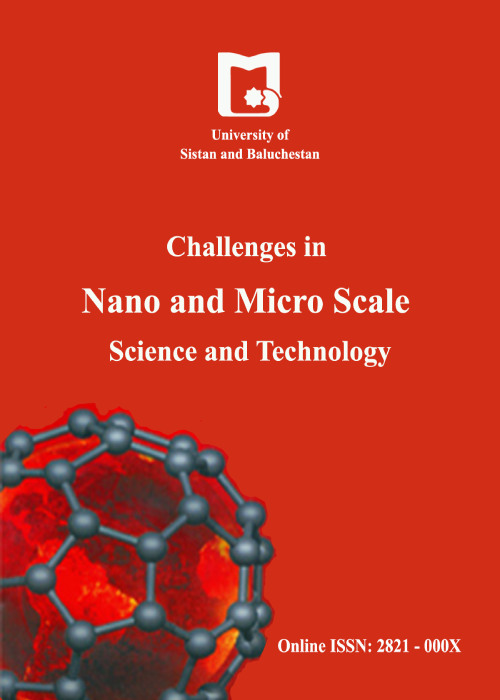فهرست مطالب

Journal of Transport Phenomena in Nano and Micro Scales
Volume:9 Issue: 2, Summer-Autumn 2021
- تاریخ انتشار: 1401/02/03
- تعداد عناوین: 7
-
-
Pages 81-88
In recent years, significant attention has been devoted to nanofluids to improve the thermal efficiency of conventional cooling fluids. Copper nanoparticles are a proper candidate for this purpose due to their high thermal conductivity. In this study, stable copper nanoparticles with a 34.5 nm average diameter were synthesized via chemical reduction without an inert environment. The synthesized copper nanoparticles and also commercial copper nanoparticles with a 40 nm average size were used in ethylene glycol as the base fluid. Viscosity and rheological behavior of these nanofluids as important factors for assessment of flow behavior in heat exchange equipment were also investigated experimentally. The effects of volume fraction and temperature on nanofluid viscosity were investigated. Viscosity was measured in a 29.5-60 °C temperature range at low weight fractions of 0.0001, 0.0003, and 0.0005. The results were compared with the proposed models for the prediction of nanofluid viscosity, suggesting a correlation. The results show the Newtonian behavior of both nanofluids. Based on the results of a previous study, the heat transfer coefficient and thermal conductivity increased significantly (38.2 % for 0.03 wt. % nanofluid at Re=68 and 39.4% for 0.01 wt. %, respectively). Also, for both cases, nanofluid viscosity was smaller than the base fluid (for nanofluid B, 12.8% reduction at 1.06 vol. %). These results suggest copper nanofluid as an appropriate alternative for application in heat exchange equipment.
Keywords: Nanofluid Viscosity, Heat transfer coefficient, Ethylene Glycol, Copper nanoparticle, Chemical reduction -
Pages 89-99
We investigate the phenomenon of electrokinetics in microchannels. Electroosmotic is one of the four electrokinetic effects. Electroosmotic flow (EOF) is caused by the application of an electric field to an aqueous solution. The characteristics of the EOF depend on the nature of the surface potential distribution. EOF in microfluidic systems is limited to low Reynolds. As a result, species mixing in EOF systems is primarily due to diffusion. The surface heterogeneous of the microchannel walls causes the production of micro vortexes in the liquid. In this study, A two-dimensional microchannel is used to study the electroosmotic/pressure driven in Newtonian fluids. The equations governing the fluid flow in a rectangular microchannel are obtained based on the Lagrangian approach and using the density-based weakly compressible smoothed particle hydrodynamics (WCSPH) method. We have analyzed the vortexes due to surface potential heterogeneity and investigated increasing the surface potential on the flow. The results show that increasing the surface potential causes the vortexes to grow and strengthens the velocity and mixing fields more.
Keywords: electroosmotic flow, Smooth particle hydrodynamics, Rectangular microchannels -
Pages 100-108In this paper, multi objective Pareto optimization of frost formation in Micro Channel Heat Sink (MCHS) with circular fins with square and triangular configurations is performed in three steps. In the first step, the fluid flow is solved numerically in a number of MCHS using CFD techniques. In numerical modeling, basic equations of humid air and frost, including continuum, momentum, energy and phase change mechanism are numerically solved. Flow type is transient and the microfluidic regime is slip flow. In the second step, CFD data is used to model the objective functions namely volume fraction of ice and the heat transfer in MCHS using GMDH type artificial neural networks. The accuracy of GMDH modeling of objective functions is investigated using different statistical models. Finally, polynomials extracted from the GMDH are used to multi-objective optimization of frost formation in MCHS using NSGA II algorithm. In this step, the Pareto front, which contains very useful information in the design of MCHS containing frost formation, will be extracted and deeply discussed. In the results section, points with unique features are introduced. It will be shown that the design information presented in the results about MCHS containing frost formation can only be extracted with a multi-objective optimization approach.Keywords: MCHS, microchannel, frost formation, CFD, slip regime
-
Pages 109-116Recently, using volumetric receivers as a novel idea to collect solar energy was considered. Solar radiation volumetrically absorbers with a heat transfer fluid which flows through a transparent tube. Nanofluids as working fluids were proposed by different researchers because of their interesting absorption coefficient as well as an important heat transfer coefficient. However, conditions such as the severe temperature gradient in absorber tubes and high temperature of working heat transfer fluid, deteriorate stability of the nanofluids. Considering the kinetic energy of nanoparticles, DLVO potential energy and steric repulsion between nanoparticles, a molecular approach is adopted to investigate the nanofluid stability for different nanofluids with polymeric surfactants and different operational conditions. Two types of polymeric surfactants were considered and stability diagrams introduced to show the conditions for which a nanofluid would be stable. In the case of using PAA for a given temperature gradient, increasing the working fluid temperature required smaller nanoparticle diameters to result in a stable nanofluid (nanoparticles up to 13.2 nm diameter) and for PMAA, a stable nanofluid can be achieved with larger nanoparticle diameters (about 80nm) while increasing the working fluid temperature.Keywords: Nanofluid, dispersion stability, volumetric receiver, DLVO, polymeric surfactant
-
Pages 117-125The temperature of the phase change material remains almost constant when the phase changes. It means that these materials have a high heat capacity during phase change. This property causes the particles containing these materials to act like distributed heat sinks throughout the field and result in heat transfer increment. However, if these particles are placed inside the thermal boundary layer, they will have a greater impact on the heat transfer rate. The vertical velocity component in the entrance length, prevents particles from being placed near the wall. On the other hand, in this study, the particle coating is iron oxide, which are able to move towards the wall by magnetic force. This magnetic field pulls the particles toward the heated wall and inside the thermal boundary layer. To solve the governing equations, two-phase Eulerian-Lagrangian model has been used. The PCM is Paraffin wax with 30 microns diameter and, particle volume concentration is 10%. This study covers a wide range of Reynolds numbers (100<Re<500), subcooling numbers up to 0.75 and magnetic field strength (H0) up to 2.1e-8 A.m-1. The results show 16.56% increase in Nusselt number for Re=100 and, H0=2.1e-8 A.m-1.Keywords: micro-encapsulated PCM, Eulerian-Lagrangian, Subcooling number, magnetic field strength
-
Pages 126-134
Friction is created in the gas seals due to the relative motion of the two fixed and rotary surfaces, causing power dissipation, erosion, heat generation and temperature rise of the surfaces so a distance between two surfaces should be created. In the structure of Dry Gas Seals (DGS), the grooves on the rotating surface are created, which is the key to the gas penetration between the surfaces. The geometrical parameters of grooves would have substantial effect on the amount of leakage, so it is of high importance to indicate the best shape and operating condition of grooves. In this research, the effect of geometric parameters of a DGS with trapezoidal grooves on the leakage rate and open force is investigated. The geometric parameters are the depth of the triangular and square sections, the length of the groove, the angle of the square part and the angle of the groove. The length of the groove has a substantial impact on leakage, and by doubling the length, the leakage rate is raised to 58%. It is concluded that when the angle of the square section is 7° and the angle of groove is 22°, the minimum leakage occurs in the range of parameters studied. Taguchi algorithm is also applied to optimize the shape parameters of the groove to minimize open force and leakage of the seal. Optimal dimensions for grooves in the range of operating conditions in this study are triangle depth=3μm,quad-depth=10μm,Length=8mm,groove angle=18°,rectangle angle=5°. The same optimum conditions are obtained by considering energy and exergy terms.
Keywords: DGS, Computational Fluid Dynamics, Open force, Leakage -
Pages 135-150This article is concerned with study of the steady and incompressible three-dimensional flow of magnetohydrodynamic couple stress nanofluids over a stretching sheet through a porous medium under influence of, non-linear thermal radiation and heat generation/absorption, taking into account effects of both Brownian motion coefficient and thermophoresis coefficient. On the other hand, the system of nonlinear partial differential equations governing the flow process has been transformed into a system of nonlinear ordinary differential equations using similarity transformations and dimensionless variables, knowing that the numerical method used to solve the new system of differential equations is the fourth-order Runge-Kutta method with the shooting technique in the code of MATLAB program. The effects of all physical parameters resulting from this study on the distributions of velocity, temperature and concentration of nanoparticles within the base fluid were studied by means of graphs that were made by the MATLAB program. Finally, some of the results of the current study showed that the effects of the magnetic field parameter and Darcy number on the velocity distribution were negative, while their effect on the concentration of nanoparticle distribution was positive.Keywords: Couple stress fluid, Nanofluid, thermal radiation, Magnetohydrodynamic (MHD), Porous media


